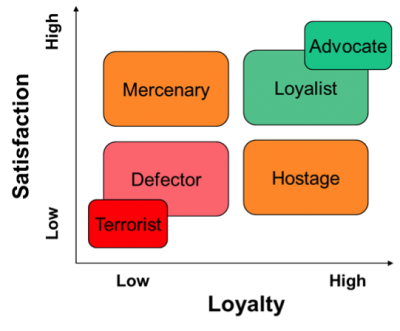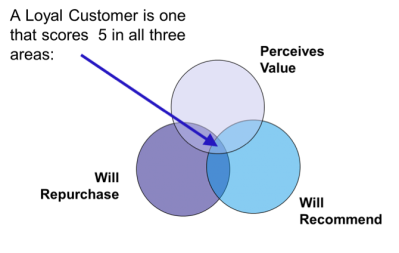Imagine you are the General Manager of a DIY store with many employees. You will be out of the country for three months and have asked your staff to e-mail you a weekly report every Monday morning. Take a moment to write down what information and metrics you would like to see in that E mail.
No doubt you will have written downs such items as sales revenue, maybe by product line, costs, overtime, profit. Possibly things such as customer complaints, refunds and stock levels.
Now imagine you need some DIY tools & materials. These may be available at several DIY stores in your area. All are equidistant from your home. Take a moment to write down what criteria you think you might use to decide which DIY store to go to.
No doubt you will have written down such items as product range, availability, customer service, delivery options and price.
If you compare the two lists they will not be the same, the former is an example of business based thinking, or voice of the business, the later of customer based thinking, or voice of the customer.
Customers’ needs are typically related to Quality, Cost and Delivery. A well know Master Black Belt once said, if you want to know what customer want, they want what they want, they want it now and they want it for free! That is what we would all have if we could. For example, most people would like a new television set with the latest features as soon as they can get it, and at the lowest price they can find.
Customers will not usually be interested in how the supplier business meets their needs, only that their needs are met. This is called the Voice of the Customer, or VOC.
WHY CUSTOMER BASED THINKING?
The importance of the customer cannot be underestimated. For most organisations, customers have a choice of where they place their business. They will place it where the combination of quality, delivery and cost best fits their needs. Those organisations that understand customer needs and are best at satisfying them will be the most successful.
Many organisations underestimate the true value of a customer. Consider the example of a supermarket shopper, shopping every week at one of the major brand supermarkets. Assume a weekly spend of £100. How much is the customer worth to the supermarket?
It depends on whether we consider profit or revenue as the worth of course, but to keep it simple let’s talk about revenue. So, for one week’s shopping, the customer is worth £100, right?
Correct as far as it goes of course, but how many weeks a year does the shopper shop at the supermarket? Let’s assume 50, allowing for 2 weeks holiday abroad. 50 times £100 is £5,000, so in a year the customer is worth £5,000 to the supermarket. So for one year, the customer is worth £5,000 to the supermarket, right?
Correct as far as it goes of course, but how many years does the shopper shop at the supermarket? Of course this is far harder to answer, and will depend on many other factors, but could easily be 20 years or more. If we assume 20 then the customer is worth 20 times £5,000, which equates to £100,000 in today’s money ignoring any inflation factors.
However, that’s not the end of the story, assuming we have a good experience with a supplier, not only will we continue to use them but we also most likely recommend them to others. Research suggests that on average if we have a good experience we will tell three other people about it, and these people may well do business with the supplier we have recommended. If we apply this logic to our supermarket example, then that’s 3 other people that will potentially spend £100,000, in total £300,000, so that’s £400,000 in total right?
However, research also tells us that if we have a bad experience with a supplier, not only will we not deal with them again if we have a choice, but also we will tell others of our bad experience! On average we will tell eight other people of our experience, and potentially that’s eight people that will not deal with that supplier. Eight times £100,000 is of course £800,000, so the potential lost revenue from bad customer service is £800,000.
Although the numbers may not work out in quite the same way for every business, the logic of working out the true value of a customer over time is sound; you will be able to check your own customers’ spend over time to see what the real value is like, rather than consider just the value of one transaction. Businesses that track source of business can also see how many referrals and recommendations they get, and factor the value of business from this source also.
Lost business because of poor reputation is harder to track. It is difficult to obtain accurate figures for loss of revenue as the precise figures will depend on the organisation, product and customer.
However, in broad terms the following facts apply:
- In the average business, for every customer who bothers to complain, there are 26 others who remain silent.
- 91% of unhappy customers will never purchase goods or services from you again.
- It costs about five times as much to attract a new customer as it does to keep an old one.
- The average wronged customer will tell eight to sixteen people.
(Source: Technical Assistance Research Programs, Washington, D.C.)
We tend to form our perceptions pertaining to “quality” when we first begin to use the product or service. This coincides with the infant mortality portion of the bathtub curve, and therefore process quality can have a large effect on the perceived quality level for a product.
The best way to deal with this is to estimate the risk of loss of business as a risk of loss of customers, for example is there a 10% risk, or a 5% risk. Assuming we know the total number of customers that complain, we can then work out the risk of lost business by multiplying this number by the risk and average customer value.
In summary, we can see that it is relatively easy to get some indication of the true value of a customer, and that this is considerably higher than we might initially imagine if we only consider the value of a single transaction.
IS JUST SATISFYING THE CUSTOMER ENOUGH?
Harvard Business School professor James Heskett developed a model that considers two factors of customer behaviour, these being satisfaction and loyalty. If we plot customers on a graph with these two factors we can categorise them into different groups.

(Adopted from James L Hasket, Harvard Business Review)
In the bottom left are Defectors – neither particularly loyal nor particularly satisfied. If they haven’t already left they may do in the future, they are often one problem away from leaving. Some will willingly become Loyalists when they receive the right product and service from a supplier.
Next across are Hostages – with medium to high loyalty but low to medium satisfaction these customers tend to be “stuck”, possibly locked in by a contract, with no easy way out or where switching costs are high.
Top left are Mercenaries – quite often the bulk of the customer base. Apparently satisfied and loyal they may switch as soon as they get a better deal without warning. Where there is plenty of choice then price is often a differentiator.
Next across are Loyalists - High satisfaction and high loyalty. Loyalists can be thought of as the bedrock of your company, they keep on coming back. However, they do not spread the word or recommend your business as much as you would like.
In the bottom left corner are Terrorists – Low satisfaction and very low loyalty. Not only will they be likely to leave, they can do huge damage to a business by spreading their comments about poor products and service to others.
In the top right corner are Advocates – the highly loyal and highly satisfied customers. They are similar to the Loyalists, but will actively go out and spread the good word. Research carried out by Xerox found that customers rating “extremely satisfied” were 6 times more likely to repurchase than those ranking “satisfied”.
Clearly what we want is for as many customers as possible to be Advocates for our products and services. Let’s now consider that we run a survey, and ask our customers to rank their agreement with the following statements from strongly agree to strongly disagree:
- I think that this product provides exceptional value.
- I will recommend this product to others.
- I will purchase future products from this company.
If we get the following range of answers how satisfied are we with our customer service?
|
Strongly agree |
Agree |
Neutral |
Disagree |
Strongly disagree |
|
|
1 |
7% |
60% |
20% |
7% |
6% |
|
2 |
17% |
58% |
12% |
6% |
7% |
|
3 |
26% |
53% |
15% |
3% |
3% |
On the face of it we may consider this to be acceptable, but for a customer to be a Loyalist or an Advocate, they will need to score top marks in all 3 of these questions. Only 7% or less could have scored top marks for all 3 questions, and it is likely that around 33% of our customers are not satisfied (scoring neutral or below). So the survey results would not give us a great deal of comfort, other than indicating some good potential for improvement!

In summary, we can say that there is a difference between business based and customer based thinking, in business improvement we need to consider not only business based thinking, but also customer based thinking because the true value of a customer is often vastly underestimated and it is not enough to just satisfy the customer. If we want our businesses to be exceptional then we have to ensure as many of our customers as possible are loyalists and advocates!